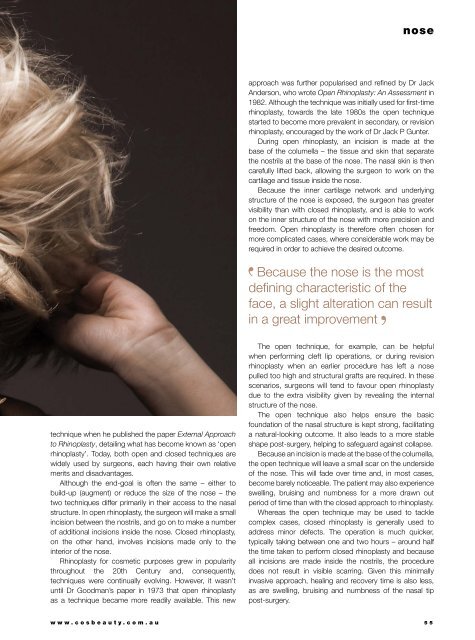Cosmetic Surgery and Beauty Magazine #68
You also want an ePaper? Increase the reach of your titles
YUMPU automatically turns print PDFs into web optimized ePapers that Google loves.
nose<br />
approach was further popularised <strong>and</strong> refined by Dr Jack<br />
Anderson, who wrote Open Rhinoplasty: An Assessment in<br />
1982. Although the technique was initially used for first-time<br />
rhinoplasty, towards the late 1980s the open technique<br />
started to become more prevalent in secondary, or revision<br />
rhinoplasty, encouraged by the work of Dr Jack P Gunter.<br />
During open rhinoplasty, an incision is made at the<br />
base of the columella – the tissue <strong>and</strong> skin that separate<br />
the nostrils at the base of the nose. The nasal skin is then<br />
carefully lifted back, allowing the surgeon to work on the<br />
cartilage <strong>and</strong> tissue inside the nose.<br />
Because the inner cartilage network <strong>and</strong> underlying<br />
structure of the nose is exposed, the surgeon has greater<br />
visibility than with closed rhinoplasty, <strong>and</strong> is able to work<br />
on the inner structure of the nose with more precision <strong>and</strong><br />
freedom. Open rhinoplasty is therefore often chosen for<br />
more complicated cases, where considerable work may be<br />
required in order to achieve the desired outcome.<br />
Because the nose is the most<br />
defining characteristic of the<br />
face, a slight alteration can result<br />
in a great improvement<br />
technique when he published the paper External Approach<br />
to Rhinoplasty, detailing what has become known as ‘open<br />
rhinoplasty’. Today, both open <strong>and</strong> closed techniques are<br />
widely used by surgeons, each having their own relative<br />
merits <strong>and</strong> disadvantages.<br />
Although the end-goal is often the same – either to<br />
build-up (augment) or reduce the size of the nose – the<br />
two techniques differ primarily in their access to the nasal<br />
structure. In open rhinoplasty, the surgeon will make a small<br />
incision between the nostrils, <strong>and</strong> go on to make a number<br />
of additional incisions inside the nose. Closed rhinoplasty,<br />
on the other h<strong>and</strong>, involves incisions made only to the<br />
interior of the nose.<br />
Rhinoplasty for cosmetic purposes grew in popularity<br />
throughout the 20th Century <strong>and</strong>, consequently,<br />
techniques were continually evolving. However, it wasn’t<br />
until Dr Goodman’s paper in 1973 that open rhinoplasty<br />
as a technique became more readily available. This new<br />
The open technique, for example, can be helpful<br />
when performing cleft lip operations, or during revision<br />
rhinoplasty when an earlier procedure has left a nose<br />
pulled too high <strong>and</strong> structural grafts are required. In these<br />
scenarios, surgeons will tend to favour open rhinoplasty<br />
due to the extra visibility given by revealing the internal<br />
structure of the nose.<br />
The open technique also helps ensure the basic<br />
foundation of the nasal structure is kept strong, facilitating<br />
a natural-looking outcome. It also leads to a more stable<br />
shape post-surgery, helping to safeguard against collapse.<br />
Because an incision is made at the base of the columella,<br />
the open technique will leave a small scar on the underside<br />
of the nose. This will fade over time <strong>and</strong>, in most cases,<br />
become barely noticeable. The patient may also experience<br />
swelling, bruising <strong>and</strong> numbness for a more drawn out<br />
period of time than with the closed approach to rhinoplasty.<br />
Whereas the open technique may be used to tackle<br />
complex cases, closed rhinoplasty is generally used to<br />
address minor defects. The operation is much quicker,<br />
typically taking between one <strong>and</strong> two hours – around half<br />
the time taken to perform closed rhinoplasty <strong>and</strong> because<br />
all incisions are made inside the nostrils, the procedure<br />
does not result in visible scarring. Given this minimally<br />
invasive approach, healing <strong>and</strong> recovery time is also less,<br />
as are swelling, bruising <strong>and</strong> numbness of the nasal tip<br />
post-surgery.<br />
www.cosbeauty.com.au 55


















